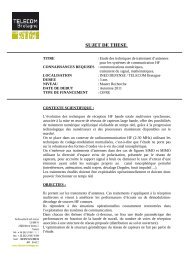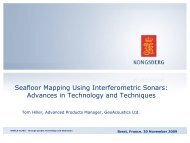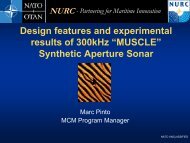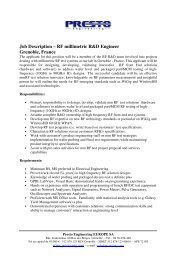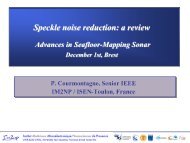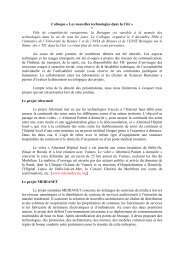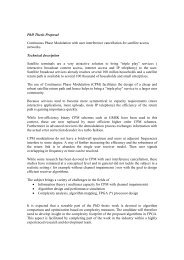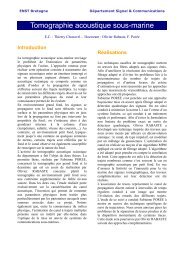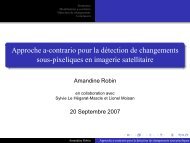Département Réseau, Sécurité et Multimédia Rapport d'Activités 2008
Département Réseau, Sécurité et Multimédia Rapport d'Activités 2008
Département Réseau, Sécurité et Multimédia Rapport d'Activités 2008
You also want an ePaper? Increase the reach of your titles
YUMPU automatically turns print PDFs into web optimized ePapers that Google loves.
Sensor N<strong>et</strong>worksRandom Walk Techniques for Data Delivery in Wireless SensorN<strong>et</strong>worksResearch Staff : Xavier Lagrange Gwillerm Froc (Mitsubishi Electric)Ph.D. Student: Issam MabroukiKeywords : Wireless Sensor n<strong>et</strong>works, Random Walk Theory, Performance EvaluationPartners & Funding : CIFRE MitsubishiIntroductionWireless Sensor N<strong>et</strong>works (WSN) have beenone of the most prosperous research areas inrecent years thanks to its wide spectrum ofpotential applications, including environmentand habitat monitoring, healthcare application,home or industrial automation and control,precision agriculture and inventory tracking.Faced to this general trend of applicationdiversification, large amounts of researchbeing done in the WSN area are trying toprovide useful tools and design m<strong>et</strong>hods forb<strong>et</strong>ter architectures and protocols.Most application scenarios for WSN involvesmall devices called sensor nodes, which areequipped with sensing capabilities, wirelesscommunication and limited power supply, CPUand memory. On top of that, sensor nodes areoften supposed to operate unattended andunder strict energy constraints. Such adverseconditions make the design of robust, scalableand energy efficient systems a considerablechallenge.Taking advantage of the fact that computationis much less energy expensive thancommunication, most existing designs consistof distributed systems, which delegate a largeportion of the information processing to thenodes themselves. However, this technique ischaracterized by its dependence on stateinformation stored in the nodes for properoperation. In a highly dynamic environment,which generally characterizes WSN, thistechnique should require the development ofsophisticated failure recovery mechanisms,thereby significantly increasing the complexityof sensor nodes, and have dramatic impact onthe overall performance.In the search of an alternative solution, manyearlier recent research efforts haveinvestigated the use of randomization to buildrobust, scalable and energy efficient protocolsin the context of WSN. One example consistsof the use of random walks to convey datafrom a source node to a destination one. Theuse of this technique is not new and has beenextensively explored in many n<strong>et</strong>workingmodels [1,2]. However, throughout the vari<strong>et</strong>yof research works that assess the effectivenessof this technique, most results are derived bymeans of simulations. Furthermore whenanalytical tools are used, the obtained resultsoften provide bounds on various performancem<strong>et</strong>rics of interest. Clearly, results of thisnature may have little consequences forpractical applications.Instead, our take in this work is to obtain afundamental insight into the random walktechnique by building various models in orderto assess the effectives of this technique basedon the derivation of closed-form expressionsfor various performance m<strong>et</strong>rics. To this end,we have extensively used the powerfulmathematical tools developed in the physicscommunity [3].RealizationThe general model consists of a typicaln<strong>et</strong>work made of two kinds of nodes: a largenumber of sensor nodes and a smaller numberof sink nodes with more complex capabilities togather, process and control data. Each sensornode performs some sensing of a particularconfined area, and sends messages to sinknodes in a multihop fashion, using othersensor nodes as relays and without anyspecific mapping b<strong>et</strong>ween sensor and sinknodes. A generated message will be trapped atthe first encounter of a sink node. We lookmore specifically at a common regular andperiodic deployment topology where nodes arespread over an area of interest with a squarepattern. As illustrated in Figure 1, this patternis formed by periodically repeated square unitcells of size N*N containing N 2 nodes of which(N 2 – 1) are sensor nodes and one is a sinknode. Clearly, c = 1/N 2 represents theconcentration of sink nodes, i.e., the ratio10 Extract of Pracom’s Annual Report <strong>2008</strong>




